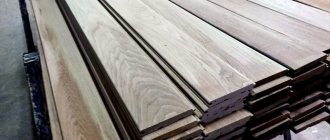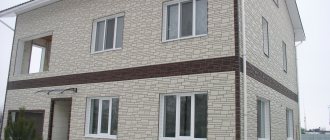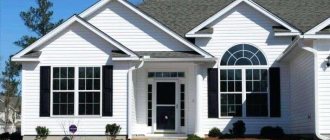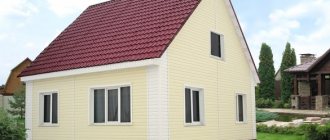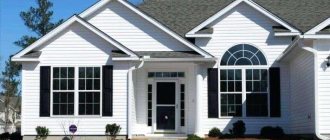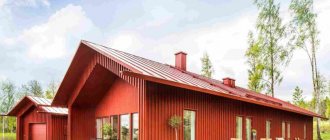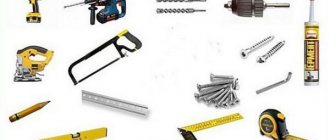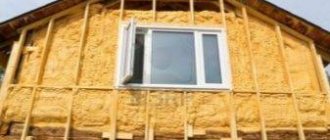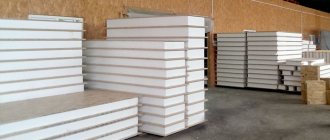×
Tips for decorating your home
What materials are right for you? How to calculate the quantity? How to install and avoid mistakes?
Subscribe to our newsletter
About the newsletterUser agreement
×
Confirm your email address!
Go to your email service right now by clicking on the icon
and you will receive a unique selection of tips on exterior home decoration from a manufacturer with 18 years of experience!
Important! If you don't receive the email, be sure to check your spam folder and move the email to your inbox if it is there.
For proper installation of siding, you need not only panels and sheathing strips, but also additional elements for connecting siding on long walls, in corners, arches, for finishing openings, as well as starting and finishing strips for the correct installation of a ventilated facade. The types, sizes and shapes of these accessories depend on the selected siding collection. Thus, various components are used for panels such as “shipboard”, block house, facade panels and foam siding.
Let's figure out what components are needed for siding, how to choose them and calculate the required quantity so that you don't have to get rid of excess or buy missing strips individually.
Types of additional elements
There are several main types of siding accessories that are used at different stages of installation:
Before installing the panels, secure the starting profile for the siding. The initial strip is attached to the frame with nails or screwed with self-tapping screws. The first panel is mounted to it.
Window strips for siding are mounted around the perimeter of door and window openings. This siding profile can also be used to cover small recesses.
To close the panel from the side, use a J-trim strip.
To join the siding along the length, use a connecting strip.
To secure the soffits, use an f-profile for siding.
The range of components for vinyl siding is in many ways similar to those additional elements that are used for installing other types of cladding panels. But there are also some differences. For basement siding, for example, a wider starting strip is used, as well as a corner element. Components for metal siding can be produced to order, up to 6 meters long.
General information about works and tools
To cover a house with siding, in general, you will need to make a sheathing. This stage of work can be omitted if the structure is made of wooden beams and the wall is flat. In any other cases, using metal profiles or wooden slats, you will need to create a base to which the siding will be attached.
Insulation is placed in the space between the elements of the sheathing (attached to metal brackets to the wall or in another way), if you want to significantly reduce heat loss in the house along with the exterior finishing, and get rid of problems with damp walls, freezing, and mold formation indoors. The metal profile, which is used when installing drywall, is convenient when creating external sheathing . However, the cost of such a solution is incomparably higher than that of the option with simple wooden planks.
Working with siding is done with the help of several tools, so as not to divide all the devices into groups, we will give a general list of what is needed to make sheathing and cover the house with siding.
- A hacksaw if you plan to use wooden sheathing strips.
- A hacksaw for cutting profiles and siding panels; it can also be used to process connecting and other components.
- A portable circular saw is extremely useful for working on metal siding.
- A drill will be needed to attach the panels; a hammer drill is also useful for installing the sheathing.
- Tape measure, metal ruler, chalk, marker.
- A building level-ruler, as well as a rope plumb line to determine the vertical when placing elements.
- Hammers of various weights, a screwdriver, an awl, a knife, metal scissors, pliers and other familiar, so to speak, accessories for carrying out various small jobs.
To successfully complete the work, you will need different types of fasteners, the characteristics of which will depend on the habits of the work performer. For example, the sheathing can be installed using Euro nails or sets of new settlers.
The only requirement for self-tapping screws for installing siding panels is that they must have a flat clamping head.
Finishing is carried out subject to strict adherence to safety regulations. It is necessary to use a fully functional tool for installing siding, attach the sheathing and cut parts while wearing safety glasses, install panels (especially metal ones) with gloves, plastic components for joining, docking and other operations are cut without excessive pressure on the knife, carefully.
Excellent results are achieved if the processing of parts (panels, special profiles) is carried out on a small workbench, stable table or other free and convenient surface.
Three basic rules to follow when installing components
The general course of work is quite simple: siding panels are installed in rows from bottom to top, which may require cutting of individual elements to form the required length of the row. Some types of metal trim need to be mounted vertically and are specifically designed for this type of placement. When installing vinyl siding, you should follow simple rules:
- the material is subject to temperature deformation, so it is necessary to leave horizontal gaps of about 4-6 mm when installing in various special profiles;
- The siding panels are not screwed tightly, the gap between the flat pressing head of the screw and the surface of the part should be about one and a half millimeters;
- installation of long panels is carried out in the following order: the edges, the center are fixed, then the screws are screwed in from the middle to the edges.
These three main rules will allow you to correctly clad any façade and ensure that the surface will look perfect regardless of any temperature fluctuations.
Lathing devices for siding installation
Even if the wall of the building is absolutely flat, it is advisable to install the siding on a metal profile. This is a simpler and more reliable option than making a frame from wooden beams. The galvanized profile for siding does not require antiseptic and hydrophobic protection. Thanks to this you will save money and time. In addition, the metal siding profile can withstand heavy loads, so it is well suited for the installation of basement and metal facade panels.
Formulas
Formula for calculating finishing area
S finish = L wall x H wall
Parametric data calculations are performed for each individual wall. The results are summed up and a single value is determined. To obtain accurate indicators, you need to subtract the area of all door and window openings from the area of the total cladding.
Formula for calculating the area of the slats
Next, it was time to calculate the area of the siding strips.
S panels = B panels x L panels
Formula for calculating the number of siding strips
Number of planks = S trim / S panels
The process for calculating gable siding is the same as for walls. The difference is that when calculating the area of the walls of a building, you need to use a formula to calculate the area of a triangle.
In order to protect yourself during the work process from a situation where there is suddenly not enough material, when calculating, provide a reserve just in case of a fire. Basically, you need to buy material with a margin of about 15% of the total siding calculations.
How to attach a profile under siding?
You can easily find the answer to this question on construction sites and forums or with the help of the video instruction “Installing a profile for siding.”
Basic recommendations for installing a profile frame for siding:
- It is advisable to choose a profile for lathing under siding with a cross-section of at least 2.7x6 cm. It has a special flange that gives it additional rigidity.
- To attach the siding profile to wood, self-tapping screws are sufficient. When attaching to reinforced concrete or brick, dowels must be used.
- The greater the weight of the finishing material, the smaller the step for attaching the metal profile under the siding should be. Please note that plinth and metal panels weigh more than vinyl. Therefore, in the video instructions for installing a profile under siding, it is recommended to maintain a distance between the planks of 0.6 meters for vinyl and 0.4 m for vinyl siding and metal siding.
- Installation of profiles under siding is done perpendicular to the direction of installation of decorative panels. In most cases, the frame is mounted vertically. The exception is the installation of sheathing for vertical siding.
- Lathing from a siding profile makes it possible to visually align the walls and install additional heat and waterproofing for the house.
Careful reading and careful adherence to the installation instructions is a guarantee of correct installation of sheathing and siding in full accordance with technology.
Siding is formatted panels that are fixed to the facade using special technology. Panels can be wood, metal, vinyl. When installing them, a number of additional elements are used, with the help of which the cladding acquires a complete appearance. These additional elements are used when decorating corners, window and door openings, and so on. And it won’t be possible to install the siding itself without them.
Let's summarize
We offer a wide range of components for finishing facades with metal siding in any color, configuration and even texture.
You can implement the most daring and unusual solutions on your façade. Especially if you “play” with contrast and use additional elements to metal siding of a different color. For example, when choosing light-colored metal siding, you can use dark-colored additional elements. This is a very well-known and popular maneuver in the design of facades.
Moreover, no matter what type of components you choose, the main thing is to adhere to and follow the Siding Installation Instructions, and everything will work out.
We hope our article was useful for you and helped you understand what parts are used for metal siding and why.
The categories mentioned in the article are:
Siding
Standard trim elements
Why are components needed?
Finishing the facade with siding has been known for a long time. Initially, it was used only as a protective cover that protected the facade from exposure to atmospheric factors. Thanks to such protection, the service life of the building increased significantly, which is especially important for houses made of wood, because wood deteriorates from negative natural factors much faster than other building materials.
Note: today manufacturers offer a wide selection of siding designed for cladding facades - made of vinyl, metal, wood and other materials. Thanks to modern manufacturing and processing technologies, all types of siding last for quite a long time - for several decades.
In order for the siding installation process to be quick and correct, and for the finished cladding to look beautiful and neat, it is imperative to use the components. These include different types of planks and profiles for decorating various parts of the building: corners, openings, roof overhangs, and so on. The components perform not only a decorative function, but also a technical one.
Siding elements and components – dimensions, characteristics.
Siding elements and components - dimensions, characteristics. We'll talk about siding. This article will help amateurs and professionals get acquainted with the various elements and components of siding. Important! You need to know that for the correct and reliable installation of siding, you need to use not only the fittings and components that the dealer recommends to you, but also correctly make the frame itself for your siding. We do not recommend that you spare money on specialized materials. Such savings can cause serious financial losses. The siding of your home is a sign of prosperity. To keep your home looking good and looking good, give your siding as much attention as you do the other parts of your home.
On the market you can find many different types of siding, for example, basement siding, metal, vinyl, their sizes, log siding sizes, panel siding, etc. you will see as you read the article. For laying siding under a log, the usual material described below is also suitable. We will also look at: basement siding, metal, vinyl sizes of these sidings.
In order to understand what the siding consists of, what are the dimensions of the siding and its components, we have compiled the following illustrated table:
Siding:
| In length | 3,050 m |
| Thickness | 0.0011 m |
| Working width | 0.17962 m |
| Area (usable) | 0.55 sq. m |
| In length | 3,050 m |
| Thickness | 0.0011 m |
| Working width | 0.25575 m |
| Area (usable) | 0.78 sq. m |
| Siding | In length | 3,660 m |
| Thickness | 0.0011 m | |
| Working width | 0.232 m | |
| Area (usable) | 0.85 sq. m |
| In length | 3,660 m |
| Thickness | 0.0011 m |
| Working width | 0.240 m |
| Area (usable) | 0.88 sq. m |
| In length | 3,050 m |
| In length | 3,050 m |
| In length | 3,050 m |
| In length | 3,050 m |
| In length | 3,050 m |
| In length | 3,810 m |
| In length | 3,660 m |
| Working width | 0.254 m |
| In length | 3,050 m |
| Working width | 0.305 m |
| Area (usable) | 0.93 sq. m |
| In length | 3,050 m |
| Working width | 0.305 m |
| Area (usable) | 0.933 sq. m |
| In length | 3,050 m |
| Working width | 0.305 m |
| Area (usable) | 0.933 sq. m. |
| In length | 3,050 m |
| In length | 3,050 m |
| Working width | 0.2032 m |
| In length | 3,660 m |
| In length | 3,660 m |
| In length | 3,050 m |
| Working width | 0.100 m |
| In length | 3,660 m |
| Working width | 0.200 m |
| In length | 3,050 m |
| In length | 3,050 m |
We also recommend:
Types of components
Based on the structural features of the building, certain types of components are selected for the façade cladding. They are usually divided into two types: decorative and load-bearing.
- Decorative ones include: end strip, soffits, trims, flashings, J-profile, near-window profile, moldings.
- Load-bearing structures are divided into two subtypes: visible from the outside and hidden. These include regular and arched J-profiles, starting strips, external and internal corner profiles, connecting strips.
Brief description of all types of components
To better understand the purpose of certain components, we offer a brief description of them.
- J-profile. Load bearing element. It is used when processing window and door openings, areas where the roof meets the pediment. It is fixed before installation of the siding begins, since the edges of the siding panels are installed directly into this profile. Sometimes the J-profile is also used as a decorative and protective element when processing corners. In this case, two profiles are attached close to each other on both sides of the corner, closing it.
- Starting/starting bar. Load bearing element. It is used at the very beginning of installation - the first siding panel is attached to it to facilitate the entire cladding process. The initial bar is set in strict accordance with the level, since if it is installed unevenly, the position of all other elements will also be distorted.
- Connecting H-profile. Load bearing element. Used to join two adjacent panels of the same row. Available in two types - standard and extended. The latter option allows you not only to connect the panels, but also to place emphasis on the joining point according to the design idea.
- J-profile arched. Load bearing element. Used to design window and door openings with an arched bend. There are notches on the profile, thanks to which it takes the required shape.
- Corner profile - internal and external. Load bearing element. It is used to decorate the corners of a building both outside and inside. The profile is equipped with grooves into which plastic panels are inserted.
- End bar. Decorative element. It is mounted at the top of the cladding in order to hide the edge of the last panel and give the facade a completed appearance.
- Soffit. Decorative element. It is used to treat the roof overhang of a building. Available in solid fabric and with perforations - holes to provide ventilation.
- Platband. Decorative element. It is used for finishing window and door openings to give them a neat appearance. Platbands are used if the openings are located on the same level as the facade walls.
- J-bevel - wind board. Decorative element. It is used to trim the edges of the roof.
- Window strip. Decorative element. It is used instead of platbands if window and door openings are recessed into the wall, that is, they have slopes.
- Molding. Decorative element. Used when decorating the internal corners of a building.
- Low tide. Decorative element. Used to drain rain and melt water from the facade and foundation.
Note: You will not be able to install siding without additional elements - at a minimum, you must use the starting strip. You can discard the remaining elements, but then the cladding will look as if it is unfinished.
Calculation of components
It is better to calculate the required number of additional elements before starting work. This can be done along with calculating the required number of siding panels. This calculation is especially important for buildings of non-standard geometry.
The easiest way is to calculate how many starting and ending strips you will need. In total, their length is equal to the total length of the walls that you are going to cover. Just measure them with a tape measure and get the desired result. And the number of planks is determined by dividing the total length by the length of one panel. Please note that waste is inevitable during any construction work, so purchase planks with a reserve.
There should also be no problems with calculating the corner profile. Measure the height of the inner and outer corners, add the values, and then divide by the height of one corner. It is necessary to take into account that it is better to sheathe corners with a solid profile or with a minimum number of joints. For this reason, professionals recommend counting the number of corner profiles for each corner separately.
The J-profile and near-window profile are calculated along the perimeter of window and door openings using the same methodology as for the elements described above.
Right choice
You must select additional elements for cladding responsibly. First of all, pay attention to their quality. It is advisable to buy components from the same manufacturer as the siding panels themselves. Otherwise, they may not fit well or not fit at all.
Attention: Select all elements strictly according to the parameters so that they fit together without gaps.
The color of the components can be chosen either to match the siding panels or vice versa - in contrast to them, if this option was intended by the designer. Please note that light-colored elements heat up and fade less under the sun than dark ones.
Note: elements with a matte surface are more practical than glossy ones, since, again, they heat up less under the sun's rays. An even more practical option is elements with a laminated surface.
Installation
Before installing panels and additional elements, you must carefully read the instructions from the manufacturer. Otherwise, you may make mistakes that are then difficult or impossible to correct. If you strictly follow the instructions, there will be no problems with installation.
In the first stage of work, install the initial strip to which you will directly attach the siding itself. The initial strip is fixed to the sheathing or to the facade wall using self-tapping screws, which are screwed strictly in the center of the special mounting holes. Then the J-profile, arched profiles (if necessary), corner profiles are installed, and the joints are processed. After this work is completed, proceed to the installation of the siding itself.
To get the job done quickly and successfully, you will need the following tools:
- Measuring tape and ruler;
- Carpentry corner;
- Screwdriver and hammer;
- Construction level, better authentic;
- Twine rope, chalk and pencil;
- Scissors for working with metal products.
Nuances when purchasing
Before you go shopping, read reviews on various websites about manufacturers and their products. When choosing material for facade finishing in a store, give preference to a well-known brand. And, of course, adhere to the following rules:
- If there is an option you like, ask the seller for a quality certificate. A responsible manufacturer always provides this information at each point of sale.
- Inspect the products, panels, and additional elements. If the elements have protrusions, curvature, or defects in the decorative layer, it is better to refuse such a purchase.
- Buy everything in one store and from one manufacturer. Preferably even from the same batch. Different manufacturers create products in different sizes. These parameters may differ even for one company from different batches. It can even be millimeters, but such a nuance causes installation difficulties.
- It is better to choose additional elements from the same material as the siding, that is, for metal siding - metal, and for vinyl - vinyl. Some believe that metal parts are much stronger, but here one of the disadvantages of this finish comes to light - linear expansion. One source material increases more and the other less.
Sometimes there are discrepancies in colors from different batches of the same manufacturer, but the markings are identical. Such shortcomings in size and color are inherent in siding for the reason that there are no regulatory documents or state standards for production.
This may result in irreparable changes to the panels or additional siding elements, which will lead to the need to redo the siding again.
Lathing for siding
The sheathing for siding can also, in some way, be called a component element. Experts advise using it even if the panels are installed on a perfectly flat façade. This is necessary in order to give the structure high strength, since it must cope well with heavy loads. This is especially important when arranging the basement of a building and using metal siding.
It is advisable to make the lathing from a metal profile with a cross-section of at least 2.7x6 cm, then it will be durable. The distance between the slats depends on the type of siding: for metal panels - at least 0.40 m, for vinyl - 0.60 m. And the interval between fasteners depends on the weight of the panels - the heavier they are, the smaller the interval. The sheathing is made perpendicular to the location of the panels: if the panels are installed horizontally, then the sheathing slats are installed vertically, and vice versa.
Siding finishing
This type of exterior cladding of the house perfectly protects the surface of the walls from precipitation, cold, heat and other adverse weather conditions. In addition, walls covered with this material take on a more presentable appearance, as in the photo. Today, clapboard is rarely used instead of siding.
After installation work, caring for the material is very simple. You can wash off dirt using regular detergents diluted in water. When purchasing components for siding, you need to consult with store employees about the sizes and shapes of the parts. If they do not match, small cracks will appear between the installed panels. Dust or precipitation may enter through these openings.
Profile for sheathing
An important factor is the uniformity of the installed coating. This concerns the functionality of individual elements, their plasticity and color. A preliminary test should show that the quality material returns to its original form.
